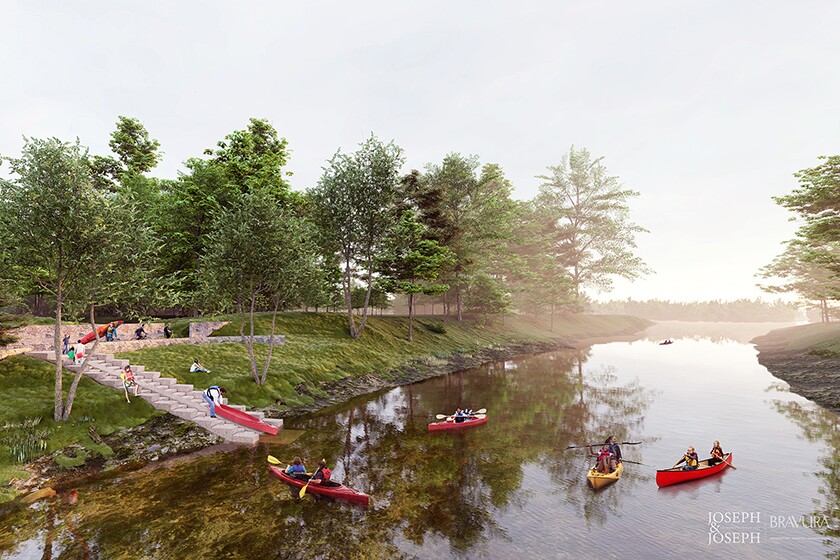The Tampa City Council is expected to approve a contract Thursday to remake Fair Oaks Park. What was envisioned as a repair job five years ago has ballooned into a nine-figure extravagance, another picture of a City Hall that cannot manage money, people or projects.
Nobody quibbled about renovating Fair Oaks when the issue first gathered steam in 2019. City officials said the aging East Tampa community center needed new flooring, carpet and windows, along with upgrades outdoors. But a parks official insisted: “Overall, this building is essentially in good shape” and pegged an overhaul at $200,000. Mayor Jane Castor agreed to renovate, not rebuild, and the council committed the money that December.
By early 2020, though, several council members were pushing to replace the community center with a new building, at an estimated cost of $4 million. That August, Castor announced the city would expand and overhaul Fair Oaks, at a cost of $18 million. The city hired a design team, which in 2022 began the “public outreach and envisioning phase.” That’s government-speak for community meetings where politicians and residents lard up the wish list.
No surprise, it worked. The plans by contractor Skanska, delivered Feb. 16, call for a new 34,000-square-foot building; basketball, pickleball and shuffleboard courts; a playground, splash pad and event lawn; electric vehicle charging stations; a shaded pedestrian plaza and jogging path and sports field with state-of-the-art artificial turf. “We have everything that you can put in a park on 10.25 acres,” a Skanska executive told council members during a presentation March 7. Area residents made more than 300 requests. “Not only did we get all of their requests in,” he continued, “but we got more than that.”
And the price went up again, too: $34,686,537 — which officials hailed as being under budget because the city was open to spending even more.
Gwendolyn Henderson, the council’s only Black member, defended the project this month as an “overdue” investment in Tampa’s African American neighborhoods. “A big, beautiful $40 million park is going to be built in a Black community,” Henderson said during the meeting March 7. “If you don’t like that, that is not something that I actually care about at this point.”
But the issue here is cost and financing, not the park’s location. Fair Oaks won’t cost $34 million; after expenses for land and other incidentals, construction costs total $41.2 million. Virtually all of that (about $37 million) will be borrowed, so add another $28 million for interest payments over the 30-year term of the bonds. That puts construction at $69 million. Add another $39 million to operate the park over the 30-year bond period. By the time it’s paid off, the park will have cost $108 million.
By contrast, Tampa spent under $36 million to remodel downtown’s Riverfront Park, its costliest park to date. Nearly half the funding came from the city’s share of the BP oil spill settlement. Compared to Fair Oaks, Riverfront cost half as much and is twice the size, and its remodel was part of a deliberate plan (that worked) to attract hundreds of millions of dollars of investment to neighborhoods west of the Hillsborough River.
Tampa should be proud of its parks. Mayors and councils for decades have wisely invested in a system that now includes 191 parks and recreation centers, which are geographically dispersed, and vary in size, character and amenities. In its latest master plan, published last year, the city rightly noted that Tampa’s parks system was “transformational” for the communities it serves. “Great parks,” the report held, “are the frameworks for livable communities,” contributing to an area’s health and wellness, economy and social cohesion. That mission is especially important in the struggling Black neighborhoods of East Tampa, which historically have never received their fair share of city attention and resources. Maintaining the parks’ quality will become more vital and challenging as Tampa grows, which is why the parks must remain a priority and supported equitably throughout the city.
But how was this project allowed to skyrocket from $200,000 to $4 million to $18 million to $34 million and beyond? Was there no middle ground? And while governments often bond for big-ticket expenses they cannot afford upfront, those typically involve major projects with long working lives, like sewers and water plants. Borrowing for bike racks and splash pads is something different altogether. Aren’t these the same city officials who cried broke only months ago in looking to increase Tampa’s property taxes?
Those who see the park as an overdue rebalancing of political spoil need to remember that there aren’t a lot of $100 million money pots lying around. As the recent master plan noted, renovating Tampa’s parks system alone could cost $743 million (in today’s dollars) over the next 20 years. Supporters of the Fair Oaks Park have the votes going into Thursday’s council meeting, but having our grandchildren pay tomorrow for a park today is not the ideal legacy project.
Governing’s opinion columns reflect the views of their authors and not necessarily those of Governing’s editors or management. ©2024 Tampa Bay Times. Distributed by Tribune Content Agency, LLC.











